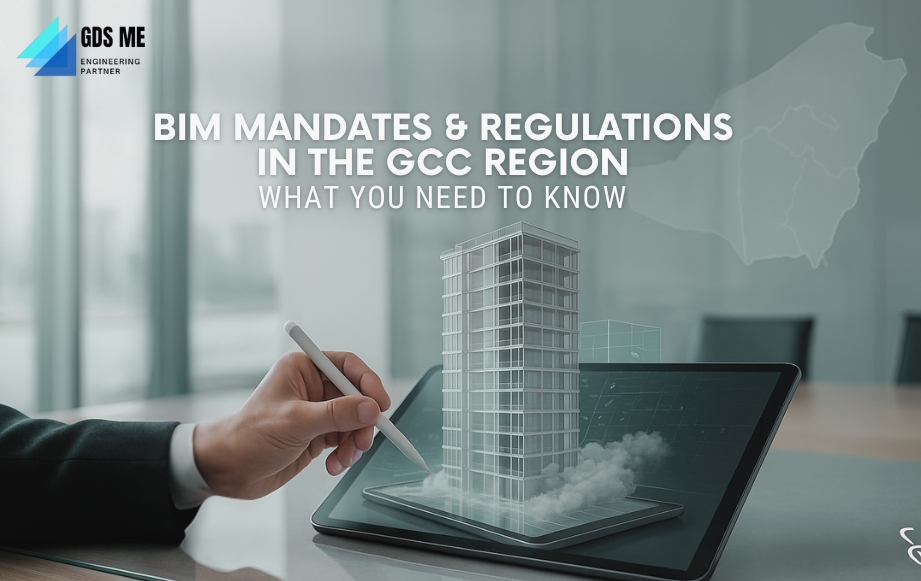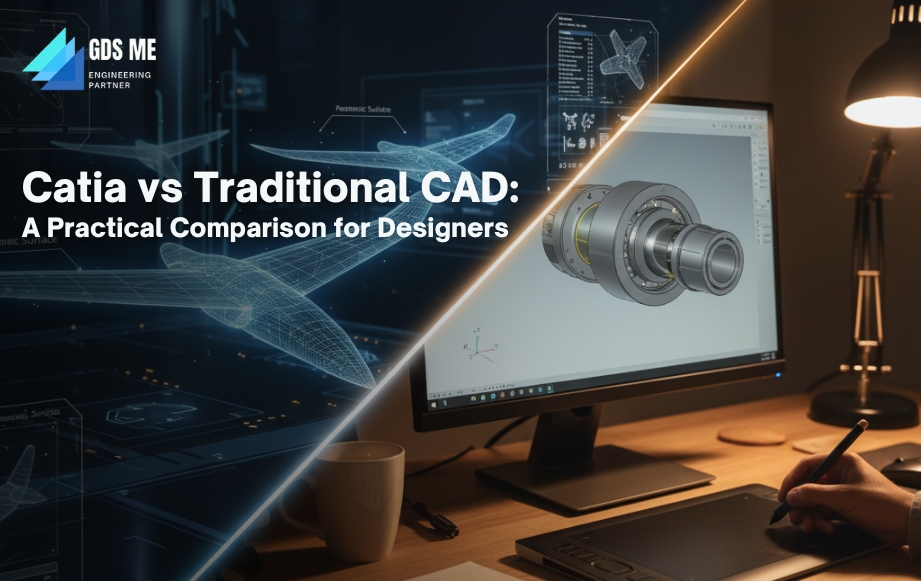Take a drive through the Gulf today, and you’ll see change everywhere. Towering hotels in Dubai, entire smart districts in Qatar, and futuristic landscapes taking shape in Saudi Arabia’s NEOM. The pace is nothing short of stunning.
But while the skyline grabs the spotlight, something deeper is unfolding behind the scenes.
The way these buildings are being planned, coordinated, and built is evolving—quietly but radically. BIM (Building Information Modeling) is now the tool that’s stitching together every floor, beam, and bolt—long before they ever appear on-site.
BIM (Building Information Modeling) is no longer just a buzzword. It’s a necessity. More governments across the GCC are making it mandatory. And that’s changing the way contractors, architects, engineers, and developers operate on a daily basis.
But here’s what matters: while the rules are evolving quickly, the right support can make the transition feel less like a roadblock and more like a smart business move.
Who Is GDS Middle East?
Behind every successful BIM journey is a team that knows the ropes—and in the GCC, Generative Design Solutions (GDS) Middle East has become that team for many leading construction firms.
Every construction project is different. Maybe you’re building a five-star resort near Jumeirah Beach. Or setting up a logistics hub on the outskirts of Dammam. Whatever your goals, the key to staying on track—and on budget—is getting the backend right.
That’s where GDS Middle East steps in.
They don’t drop off a PDF and leave. They walk with you—planning, training, troubleshooting, and making sure BIM actually supports your project goals.
Here’s what they do best:
- Create clear BIM strategies and documentation tailored to your industry standards
- Train your team hands-on—whether they’re freshers or seasoned engineers
- Set up CDE to keep your entire team—designers, contractors, and clients—on the same page
- Automate routine tasks using Dynamo, so your staff can focus on real work
- Streamline collaboration across architecture, MEP, structure, and facility teams
At the end of the day, it’s not just about using BIM to meet a requirement. It’s about using it to build smarter, faster, and better.
With BIM, It’s All in One Smart Model
A 3D version of the entire project, which also includes timelines, cost calculations, equipment specifications, safety checks, and future maintenance details.
That’s why governments are pushing BIM. It doesn’t just make your job easier—it helps avoid costly delays, errors, and miscommunication.
Government Mandates and Regulations in the GCC
Dubai, UAE
Dubai was one of the first to get serious about BIM. Since 2014, major projects needed to follow BIM standards—but as of January 2024, it’s official: full BIM submissions are now mandatory for most infrastructure and large-scale buildings.
The municipality wants every stage—from design to execution—to align with ISO 19650 data protocols. That means if you’re not BIM-ready, you might struggle to even get permit approvals.
Dubai mandates BIM for new buildings – Global Construction Review
Saudi Arabia
Saudi Arabia made a bold move. From January 1, 2024, BIM is compulsory for all new construction projects managed by the Ministry of Municipal, Rural Affairs, and Housing.
For example, firms working on Vision 2030 now need to adopt BIM—not just for design, but for entire lifecycle planning.
Contractors report fewer coordination issues on-site, better resource tracking, and improved decision-making since implementing BIM workflows.
Qatar
While there’s no blanket BIM law in place (yet), Ashghal, the country’s Public Works Authority, is leading by example. Major infrastructures in Doha—already uses BIM.
In one case, a contractor working on a mixed-use tower in Lusail avoided rework costs by identifying MEP clashes six months before ground-breaking—thanks to a coordinated BIM model.
BIM and Digital Construction: Qatar’s Road Map and Strategy | Autodesk University
Need Help Navigating GCC BIM Mandates?
So, your team just won a contract in Abu Dhabi. Or you’re about to submit a bid for a mixed-use development in Riyadh.
But the client requires ISO 19650 compliance. You’re not sure what documents you need. Or how to set up the right workflows. Sound familiar?
That’s where GDS Middle East steps in.
With a decade of hands-on BIM consulting across the region, GDS helps businesses like yours:
- Break down and understand local BIM mandates
- Align your documentation with ISO standards
- Create clear, project-specific BIM Execution Plans (BEPs)
- Train your team—onsite or remotely
- Set up collaborative environments like Autodesk Construction Cloud
Whether you’re building in Sharjah or setting up in Jeddah—contact GDS Middle East today and make BIM work for you.
Why More GCC Builders Are Embracing BIM – The BIM advantages
Building Information Modeling isn’t just a new tool—it’s a new way of working. Here’s how it’s quietly transforming the AEC industry in the GCC.
1. Everyone’s On the Same Page—Literally
In a typical construction project here, you’ve got local architects, structural consultants from abroad, and a dozen subcontractors working at once. BIM brings all these pieces together in one place. Everyone—from the electrical team to the interior designer—works on the same digital model. Changes are updated in real-time.
2. Costs Stay Under Control
With BIM, cost estimates are built into the system. Every quantity is tracked, and a cost tag accompanies every change. This helps project managers in the GCC—especially those working under strict budget caps—stay one step ahead.
3. Deadlines Get Realistic Again
In cities racing to finish airports, stadiums, or high-rise towers, every day matters. BIM accelerates the process by identifying and resolving issues before construction begins. For Gulf projects with tight delivery windows, that’s a serious edge.
4. Fewer Surprises, Less Risk
The software identifies clashes—such as pipes running through beams—before a single brick is laid. That means fewer site disputes, fewer last-minute fixes, and fewer costly arguments about who’s to blame.
5. Sustainability Isn’t Just a Buzzword Anymore
Governments across the Gulf are pushing for greener buildings. BIM helps designers include energy-saving strategies right from the start—whether it’s choosing better insulation or testing natural light angles.
6. Change Orders Don’t Break the System
When client demands can shift mid-project, with BIM, you don’t lose your footing. Updates go into the model. Everyone sees the impact. Materials adjust. Costs recalculate. Suddenly, that unexpected change doesn’t feel so overwhelming. It turns confusion into a clear plan of action.
The faster you adapt, the more prepared you’ll be to compete—whether it’s for government tenders, smart city projects, or private sector builds.
How to Make Your BIM Outsourcing in the GCC Truly Work?
- Pick a partner who understands GCC codes and climate realities.
- Desert heat, sandstorms, local material behavior—these matter more than you think.
- Don’t outsource everything—keep decision-makers in-house.
- Let your external team model; you handle the approvals and client calls.
- Ask for live model reviews, not just weekly reports.
- A 20-minute walkthrough beats flipping through 50 emails.
- Clarify time zones and communication gaps early.
- You don’t want to wait 12 hours for a clash fix when your site team’s on standby.
- Make sure your outsourced team is Revit-savvy and project-smart
- Fast modeling means nothing if they don’t “think” like builders.)
- Keep your BIM clean and organized—it’ll help you scale up later.
- Especially useful for GCC firms working across the UAE, KSA, and Qatar.
- Treat your BIM partner as part of your team—not just a task handler.
- Shared wins foster long-term trust, particularly in relationship-driven Gulf markets.
Introducing GDS – Generative Design Solutions Middle East
At GDS Middle East, we help you do more than just manage BIM—we help you make it work.
Already trusted by over 500 clients across the GCC, GDSME is known for helping AEC teams build smarter, faster, and with more confidence. With over 30 experienced engineers and strong local insight, we stay with you through every phase.
Why Choose GDS?
- We speak your language.
- We understand local construction culture, rules, and the real issues you face on-site.
- We guide, not just deliver.
- Need help with BIM Execution Plans, clash detection, or managing design changes? We’ve got your back.
- We help your team grow.
- From Revit tools to ACC onboarding and template creation—we help your people adapt with ease.
- We go beyond modeling.
- From Dynamo automation to Scan-to-BIM and facility management—we bring BIM into every stage of your project.
- We keep everyone on the same page.
- Architects, MEP, structural teams, or cost consultants—we coordinate models so your teams stay aligned.
BIM is becoming the standard across the GCC—and the right support can make all the difference. With GDS by your side, you’re not just compliant—you’re ahead.
FAQs
A: Yes. We treat your data with the utmost care and work as an extension of your team.
A: No. We stick to global standards and local codes with checks at every step.
A: That’s okay. We walk with you—step by step—until it clicks.
A: We’ve done airports, stadiums, towers—you name it.







